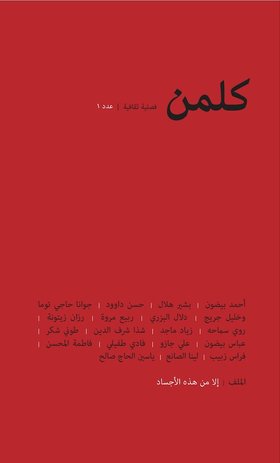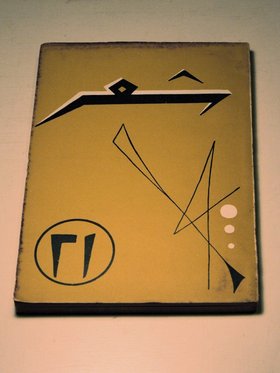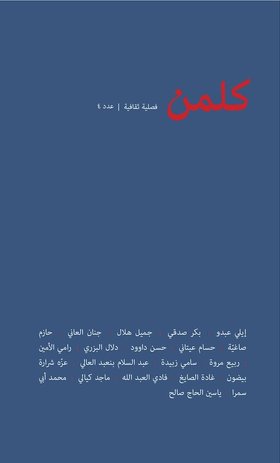Essays
Comparative Notes on the Cultural Magazine in Lebanon
INTRODUCTION
Magazines are often an indication of the intellectual and cultural life of a city or country at a specific point in time. Beirut's history of avant-garde magazine production between the 1950s and 1970s is a rich and largely untapped archive for cultural critics to mine. Here, Mirene Arsanios, a writer and art teacher at the American University of Beirut, delves into this relatively unexplored historical period to understand the mandates, positions and even rivalries between some of the magazines produced during this creatively fertile period. For historical perspective, she also speaks to editors of current and forthcoming publications in Lebanon, such as Kalamon and Portal 9, for their take on the function of cultural magazines in general, and the specifics of their own projects.
COMPARATIVE NOTES ON THE CULTURAL MAGAZINE IN LEBANON
In starting up a magazine there is usually a desire to express a take on the present. The 'modern' cultural magazine normally highlights a constellation of writings, topics, images and conversations that were not visible in this particular format or arrangement prior to its creation. Even if it is not expressly framed by its editors as a pulse-monitoring device, the magazine is somehow always, already a sign of the times. As a catalyst for thinking that is anchored in a certain production process, the magazine is often an interesting instance of the material expression of an epoch. It is most often embedded in a specific context and universe, constrained by deadlines, dependent on funding, and is always anxiously scouting for the 'new', or for the edge it may or may not have over other, similar publications.
Entrenched in the present, with one eye to the future and one to the past, the magazine is caught in a swaying movement between pragmatism on the one hand and ideals on the other. A key challenge is that of keeping a distinct voice, unmuffled by financial restrictions and agendas, all the while sticking to early, sometimes utopian, editorial intentions.
Beirut is said to have a rich history of magazine production, especiallyfrom the 1950s to the late 1970s, yet the magazine genre has not very often been critically or historically considered.[1] This article wants to think through some examples of Lebanese cultural magazines by questioning the artistic and literary mandates at the heart of these projects. Comparing past, present and future initiatives puts into perspective the 'modernity' that various publishing projects once sought, and brings to the fore the motivations behind printed magazines today.
'The main issue as I see it, is that almost all Arab, Lebanese magazines are ideological mechanisms'.[2]
Given this rich history of magazine production, it is important to look at some projects that try to resist falling prey to political agendas. By articulating certain needs and gaps, and encouraging literary and artistic experimentation, some newer magazines are attempting to propose an alternative to the binary system regulating Lebanese society and politics today. Can the material speak for itself?
In a recent interview with the editors of Portal 9, a forthcoming literary with a focus on the urban, I asked Editor-in-Chief Fadi Tufayli and Managing Editor Eyad Houssami about their position regarding the magazine's inititation and sole source of funding by private real-estate company Solidere.[3] For some commentators, this direct affiliation could be off-putting for editors, writers or future readers who are politically disinclined to associate themselves with Solidere's discourse and interests. Houssami believes that 'high quality content will prove itself. After the first two or three issues, people will draw their own conclusions about the politicized nature of this project, and whether or not biases or prejudices people had were in fact justified. We are addressing the challenges of these biases and prejudices […] I think that it's a testament to moving beyond the political binaries that do little to advance intellectual and cultural conversations'.[4]
Kalamon was founded in 2010 by a number of seasoned Lebanese academics, journalists and critics such as Hazem Saghieh, Abbas Beydoun, Manal Khader and Ahmad Beydoun among others.[5] In an early editorial, the group stated that: 'Newspapers, broadcasting stations or TV stations [make it] difficult to talk about media communication; one which is free from the certitudes and agendas of its financers and supporters.'[6] Its aim is to widen the range of readers and writers in an effort to enrich and be enriched by a plurality of opinions and positions, all the while remaining very wary of narrow, ideological messages.
Founded in 1957, Shi'r's stated mission was to revive Arabic poetry and to free it from formalism and the crushing weight of tradition. It was also one of the first movements to experiment with prose poetry. In a conference titled 'The Future of Arabic Poetry in Lebanon', delivered on the 31stof January,1957, at the Lebanese forum, al Nadwa al-Lubnaniyya, Youssef el Khal, the magazine's founding editor, outlined the movement's programme. It claimed a desire to 'replace ancient words and expressions, deprived of life, by others, new, drawn from the experience [of the poet] and from the life of the people'.[7] Shi'r was repeatedly accused by its historical enemy, the literary magazine al-Adab, of destroying Arabic's rich traditional heritage. To these accusations, the editors responded: 'Shi'r is innocent. We reiterate that our movement has no ideological or political affiliation. It is entirely dedicated to poetry. This will be apparent in its deeds, not merely in words … To transpose an ideological and political conflict into the realm of poetry is truly regrettable and damages the poetic cause to which Shi'r has devoted itself.'[8]
These magazines attempt, each in their own way, to break away from a set language, from a known city, and from the dominant realm of politics.
Ideally, magazines are the result of shared concerns, heated conversations and intense friendships. This is something quite specific to the avant-garde magazine, which becomes a means through which to express a programme or an artistic mission. Although reliant on individual contributions, the group is often subsumed by an overall project. Shi'r – being the best example of an avant-garde magazine in Lebanon – was run by poets such as Youssef el Khal, Adonis, Ounsi el-Hajj, Fouad Refka, Jabra Ibrahim Jabra, who were also part of the Shi'r movement. This included Shi'r magazine, an eponymous publishing house and a weekly meeting held on Thursdays, in which members would discuss and read their work. The strong editorial 'we' behind a magazine project generally expresses the attempted parity between the editors' mission and the content – a promiscuous, shared space with sometimes interchangeable roles between editors, writers and contributors.
In a sense, it is this 'we' that can become problematic when – in containing both the individual and the group - at times sidelines personal aspirations and positions that fall by the wayside of common projects and produces a 'groupthink' of sorts. Fall-outs and new additions are customary in historical avant-gardes publications, which are then often rebranded with a new manifesto, leader or direction. Notwithstanding the different rivalries and desertions throughout Shi'r's existence, for the most part, the magazine adhered to the principles of its initial ten-point manifesto. Such adamant stances didn't spare it criticism from opponents, who sometimes accused it of being an individualistic, colonial and Western project (being founded in the 1950s, in a post-independence atmosphere and in the midst of a period of historical transformation in the Arab world).[9]
With the decline of the modernist project, the vigorous 'we' of collectives such as Shi'r became increasingly difficult to posit.[10]
How, then, does one find another artistic or political language for engagement today? The impetus behind the founding of Kalamon is an attempt to articulate a common 'we', gathered around a negative rather than a positive affirmation. Hazem Saghieh reads this distinction as an impossibility to sustain clear-cut ideologies, which in any case have been proven to be historical failures: 'If one already knows [as in parties driven by an ideology], there is no need to question things anymore. This is the essential difference between the liberal and the non-liberal. The latter is not quite sure of what he wants, but knows what he doesn't want.'[11] This negative affirmation is motivated by a positive one.
There is a pressing drive behind the creation of this publication, although its intent (and consequently its content) is not as 'programmatic' as magazines such as Shi'r. It is important to note, however, that even the latter was on a quest for the unknown. Ounsi el-Hajj wrote in the introduction of his 1960 collection of poems Lan: 'We write in order to traverse, and what we write is folded, burned. It is what we haven't written yet, what we still ignore or haven't explored, that is our concern.'[12]
Kalamon also sees itself as belonging to the legacy of the magazine as a tool for cultural and intellectual advancement. It questions the role of the public intellectual today, and although it is autonomous and claims to be experimental about its own form, its declared and undeclared political purpose is still paradoxically unknown.
Not much can be predicted about the upcoming Portal 9. It is still in the early stages of its conception, and as such this presents a defining moment for its future. While advocating open conversation and intellectual advancement, the magazine seems to avoid a 'we' in its rhetoric. Rather than inscribing itself in the tradition of the engaged magazine, Portal 9's motivations seem to be radically different. Its purpose is not to create a 'third sphere' of expression or to fight for literary advancement but it is however intended to be literary in nature, the first issue being directly inspired by Fernando Pessoa's urban stories and imaginary.
The Public Intellectual
How can the role of the public intellectual be fulfilled if positions are never quite affirmed and what is sought is in fact in a state of permanent becoming? Edward Said described the public intellectual as '…Someone able to speak the truth to power, a crusty, eloquent, fantastically courageous and angry individual for whom no worldly power is too big and imposing to be criticized and pointedly taken to task'.[13] As such, rather than angry opposition to power and direct confrontation, the intellectual's task today is to find a way to address these struggles by uncovering mechanisms and steadily excavate the workings of power. For some of the editors at Kalamon, the public intellectual comes into existence in between disciplines, when the poet meets the academic, journalist, artist and writer. The formation of an 'intelligentsia' capable of producing conversations and new discourses works both horizontally (across disciplines) and vertically (through generations). Ideally, a magazine's stated task is to delineate a territory whose borders are continuously threatened by official discourse. It embodies that subtle struggle, which can also provoke momentary sparks.
In relation to the public sphere, it is interesting to note the relation between the magazine and the newspaper within the Lebanese context. Fadi Tufayli decided to work on Portal 9 after spending ten years writing for Nawafiz, the cultural supplement of the Lebanese daily, Al Mustaqbal. Nawafiz shares Portal 9's editorial concerns, namely an interdisciplinary approach to Beirut's urban history throughout the twentieth century. Tufayli describes Nawafiz as an autonomous cell within the newspaper, strong enough to run articles and op-eds that critique the paper's political positions and backing.
Kalamon is also made up of writers and journalists involved in some way in different Arab or Lebanese newspapers. As such, one of the declared driving forces is said to be the creation of a 'third space' in which to short-circuit the logic of mere information and propaganda, and allegedly be a place for some writers to venture away from dominant rhetoric and an acquired readership. The public sphere such magazines may be able to produce might only be visible and actual at a later stage, perhaps even when the magazine goes out of circulation and is revisited in another, future, historical context. It is perhaps this last point that is the most challenging. How does the publication produce a new public, and consequently, a public sphere where the terms of the discussion are in the making?
Finally, in Lebanon, the struggle for many is to find a Modus Operandi beyond the binary divisions that regulate most aspects of social, political and urban life. For 'pure' content to exist despite or outside of the actual production process (funding, circulation, readership) is an extremely difficult task, as the content is very often determined and shaped by these very processes. The non-political, content-driven magazine is of course political in any case. Its language, aesthetic, cover design, retail price, paper quality, distribution and circulation are all elements involving a certain politics. What magazines can hope to achieve in terms of creating publics, circulating ideas and critical contributions is not necessarily contained in its object, but rather produced by being read, stored, discussed, re-read, and re-discovered in the future. To compare historical magazines to more recent or future ones is like uncovering the archaeological traces of a fleeting production. They become the signs of an epoch, the contents of which resurface in unpredictable ways once de-contextualized. Past and present materials enter into a dialogue with one another, as the magazine mutates to accommodate different modes of production and distribution in an always difficult synchronization with the present.
[1] For instance Shi'r (1957-1970), Al-Adab (founded 1953), Al-Majallah (1956-1969), Al Hikma (1951-1965), Adab (1962-), Mawakef (1968-1998) and Al Karmel, to name but a few.
[3] Solidere is a private real estate company, responsible for Beirut city centre's contentious, post-war reconstruction. Founded by the late Prime Minister Rafik Hariri, the company was accused by many of questionable methods of expropriating former landowners.
[5] Its editors include Ahmad Beydoun, Bachar Haïdar, Hazem Saghieh, Houssam Itani, Hassan Daoud Rabih Mroueh, Samer Frangié, Abbas Baydoun, Azza Charara Beydoune and Manal Khader.
[7] Dounia Badini, La Revue Shi'r/Poésie, et la modernité poétique arabe Beyrouth(1957-1970) (Paris: Actes Sud, 2009), 44.









